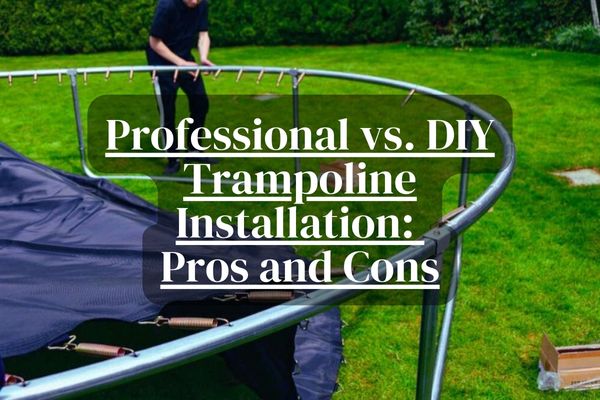Installing a trampoline in your backyard can provide hours of fun and exercise for the whole family. But when it comes to setting up a trampoline, you have two main options – hiring a professional installation company or taking on the DIY route.
Both options have their own sets of advantages and disadvantages. This article will examine the key pros and cons of professional trampoline installation versus doing it yourself.
Professional Trampoline Installation
Professional trampoline installation involves hiring a company that specializes in trampoline set-up and maintenance. The installers will come to your home with all the necessary tools and expertise to put together your trampoline safely and efficiently.
Pros of Professional Installation
Expertise and Experience
The biggest advantage of using professional installers is that they have extensive knowledge and experience setting up trampolines. They regularly install trampolines as part of their business, so they know all the intricacies involved, from selecting the right location, preparing the surface area, properly assembling the frame and mat, attaching the springs, etc. As experts, they can ensure your trampoline is sturdy and installed correctly.
Safety Assurance
Proper setup is key to maximizing safety and preventing injuries from occurring on the trampoline. Professionals are trained on safety protocols and standards to ensure your trampoline is as secure as possible. They know how to properly assess the site, handle the materials, position the trampoline, and attach protective padding and enclosures. Their expertise goes a long way in preventing common trampoline hazards.
Time-Saving
A professional team can assemble and install a trampoline rather quickly, saving you a lot of hassle and time. The process may take them only a few hours from start to finish. Whereas a DIY install can eat up an entire weekend with the learning curve involved. The time savings with professionals are important if you want your kids bouncing sooner rather than later.
Warranty Considerations
Many trampoline manufacturers require professional installation to validate the product warranty. Doing it yourself risks voiding the warranty if anything goes wrong. With professional handling, you can ensure the warranty remains intact.

Cons of Professional Installation
Cost
The most obvious downside of professional installation is the added cost. Hiring a company to set up your trampoline can get quite pricey depending on the size of the trampoline and the complexity of the job. Expect to pay at least several hundred dollars, which is over and above the cost of the trampoline itself.
Scheduling Constraints
You have to arrange your schedule around when the professional installation team is available to come install the trampoline. Weekends tend to be booked up far in advance, so you may need to take time off work for the install date. The timing should be coordinated meticulously with the trampoline delivery as well.
Limited Customization
With DIY installation, you can customize certain aspects like the exact trampoline positioning. But professionals usually have a set process they follow which doesn’t allow for as much customization. You also have less control over the pace and details of the installation when leaving it to the professionals.
DIY Trampoline Installation
Doing a trampoline installation, yourself is the more affordable and customizable option, but also requires a lot more time, effort, and care.

Pros of DIY Installation
Cost Savings
The most obvious benefit of a DIY trampoline install is avoiding the cost of professional installation services. Outside of the trampoline purchase price, you won’t have to pay any added labor fees.
Customization
You can choose the exact placement, configuration, and additional accessories like ladder positions when you handle the installation yourself. You’re not limited by any standardized processes.
Satisfaction of Self-Installation
Some homeowners get satisfaction from DIY projects like trampoline setups. The feeling of seeing the full installation process through with your own hands can be very rewarding.
Cons of DIY Installation
Time-Consuming
Be prepared for the installation to take up most of your weekend, especially if it’s your first time. From unpacking all the parts, deciphering the instructions, clearing the area, laying out the frame, attaching the mat and padding, etc. – it is an involved process. Rushing through it also raises safety issues.
Learning Curve
Without prior experience setting up trampolines, expect a substantial learning curve to the process. Be prepared to re-do some steps and make mistakes that will slow you down. Consulting online tutorials can help flatten the learning curve.
Physical Labor
Hoisting heavy frame parts, bending springs into place, and other installation steps require physical strength and stamina which can be taxing. Having a partner helps split up the labor. But it remains a physically draining process.
Safety Risks
Without professional expertise, the margin of error increases, whether it’s improper frame alignment, unstable base support, or weak spring connections. A seemingly minor mistake can seriously impact the safety of jumpers down the line.
Voided Warranty
Similar to professional installation, a DIY setup may void the manufacturer’s warranty on the trampoline if anything goes wrong. Carefully check warranty terms first before starting the installation yourself.
Factors to Consider when Choosing Installation Method
Selecting either professional or DIY trampoline installation comes down to considering several important factors:
Budget
The cost of professional installation services can range from $200 up to $1000 depending on the size and complexity of the job. For homeowners on a strict budget, taking the DIY route is the most affordable option. The only costs will be the tools and materials you need to purchase. But if you have room in your budget for installation services, the added cost brings safety and convenience benefits.
Skill Level and Experience
Assembling a trampoline properly requires some mechanical skill and experience. Those who are not adept with tools, building equipment, and following technical instructions tend to struggle with DIY installation. If your skillset leans more towards arts than construction, professional installation is probably the wiser route.
Safety Concerns
Safety is paramount with any backyard trampoline, especially with children using it. Professional installation offers peace of mind that safety protocols are being thoroughly followed. DIY installation can compromise safety if not done meticulously at every step. Carefully assess your confidence level in assembling it yourself without cutting corners.
Warranty Implications
Most trampoline brands require professional installation to keep the product warranty valid. Improper DIY installation often voids the warranty due to increased risks of problems. Check the warranty terms carefully before deciding, as professional installation may be mandatory for warranty coverage.
Trampoline Type and Size
Basic round trampolines are easier for DIY installation than more complex rectangular or oval-shaped models. Likewise, the larger the trampoline size, the more challenging and risky installation becomes without professional help. Consider your specific trampoline type and size when deciding on the best installation method.
Tips for Successful DIY Trampoline Installation
If you choose the DIY route, here are some tips for maximizing safety and success:
Gather Necessary Tools and Equipment
Having the right tools like spring tools, hammers, ladders, drill, socket set, etc. goes a long way in easing the installation. Purchase any tools you may not already own. Also gather ample protective gear like gloves, goggles, and knee pads to stay safe during the process.
Follow the Manufacturer’s Instructions Precisely
Carefully read through all instructions beforehand. Then follow each step exactly as stated by the manufacturer without taking shortcuts. Missing any assembly details or procedures can severely compromise the integrity and safety of the final product.
Ensure Proper Location and Ground Preparation
Choose a level install site away from trees, fences, and other obstructions. Clear away all debris and rocks before laying out the frame. An improperly prepared site makes installation much more difficult and dangerous.
Assemble with a Helper if Possible
Having an extra pair of hands to help with lifting, stabilizing, and attaching parts makes the whole process much easier. A helper also provides a second set of eyes to ensure each step is done correctly.
Regular Maintenance and Safety Checks
Once installed, be diligent about regular maintenance like re-tightening springs and checking for worn parts. Leaving safety issues unchecked negates all the hard work put into proper DIY installation.
Conclusion
When preparing to install a backyard trampoline, carefully weighing the decision between hiring a professional versus DIY comes down to budget, skill level, warranty terms, safety priorities, and trampoline specifics.
For most homeowners, professional installation provides the best assurance of safety, proper setup, and ongoing warranty coverage. But DIY installation remains a smart option for the handy, budget-conscious trampoline owner willing to put in the time and effort. Whichever path you choose, maintaining the trampoline diligently after installation ensures your family will enjoy years of healthy, active play.
Last Updated on November 17, 2023

